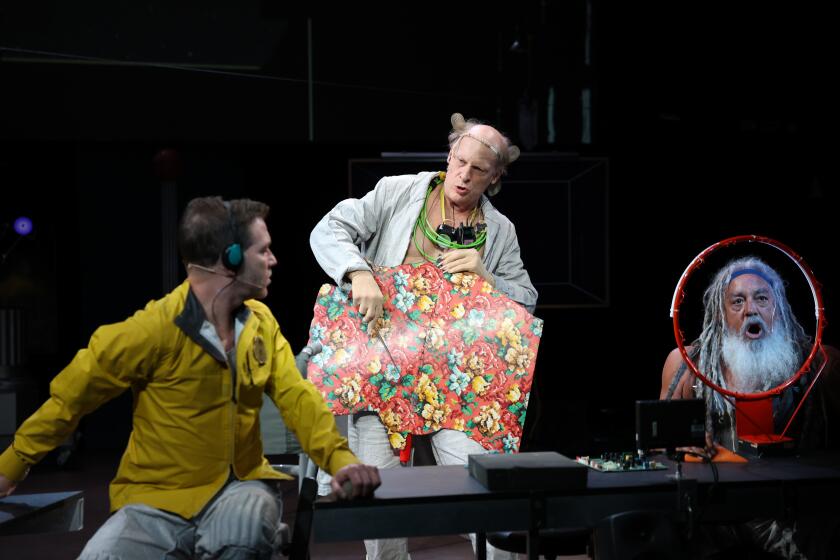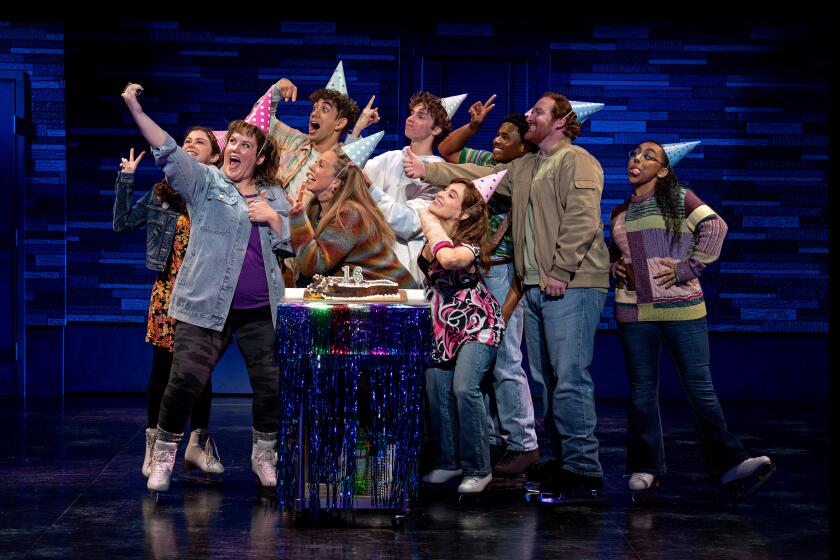UP THE COAST : A Decade of Casting Spotlight on the Disabled
A little more than a decade ago a fifth-generation Santa Barbaran named Rod Lathim made a big decision about his life--he decided not to spend the rest of it planted behind a desk.
Sounds innocent enough, nothing earth-shattering. But, from that fairly routine thought, evolved something that would affect not only his life but the lives of people nationwide.
Lathim, with a background in music therapy from the University of Kansas, formed what would come to be known as Access Theatre, a group of disabled, able-bodied and hearing-impaired actors who, through their plays and by their deeds, came together to address the needs of disabled people.
What started as a grass-roots theater struggling for local acceptance has become an award-winning company that tours nationally. A 1988 segment of the “Sunday Today Show” focused on the company’s most recent production, “Storm Reading,” and actors from the company appeared on the NBC special “From the Heart.”
The company received a Princess Grace Award for excellence in 1985. In 1987, it received a Media Access Award, given by the California Governor’s Committee for Employment of the Handicapped for the group’s accurate portrayals of disabled people.
Access Theatre has been credited with breaking ground for similar theater groups nationwide that address issues important to disabled performers and audiences.
The group is pleased with its success and will celebrate with a slightly belated 10th anniversary gala Saturday at the Lobero Theatre in Santa Barbara, site of the company’s first performance. Current and former cast members will be on hand for a dinner and a retrospective, featuring excerpts of the troupe’s current hit, “Storm Reading.”
As with all of Access Theatre’s performances, the productions will be interpreted in sign language. The show begins at 7:30 p.m. Tickets are $100.
“Ten years ago we were about as low as you can get with a community theater,” Lathim said. “We were non-professional, bare bones. Our goal was to use theater as a tool for positive social change.”
Through a combination of good reviews, good advertising and word of mouth, said Lathim, the group developed a following. Schools and theaters around Southern California began booking it.
“As our touring range grew, the quality of our work increased, said Lathim. “It was a snowballing effect.”
The increased popularity of Access Theatre and similar troupes, as well as the success of films such as “My Left Foot” and “Children of a Lesser God,” said Lathim, have helped make audiences more comfortable with and accepting of disabled performers. But, he said, there is still a long way to go.
“I have to describe myself as an eternal optimist, but I’m a realist,” Lathim said. “We’re dealing with human nature. There are still people in Santa Barbara who haven’t seen us. They think what we do is great, but they still think of us as a handicapped show.”
It’s not only the potential audience that has a difficult time accepting disabled actors. Even fellow actors find it a challenge.
“It opened my eyes to disabilities and attitudinal barriers,” said Remi Sandri, a non-disabled member of the Access Theatre cast in 1983 and 1985-1986, who is in his third season with the Oregon Shakespeare Festival.
“People get uncomfortable around disabled people. They are afraid it might rub off on them. The group doesn’t ask for pity. They don’t want you to say, ‘Oh, how wonderful, disabled performers.’ They are professionals.”
Tamara Turner, a member of the cast in 1982, has found other performance groups less accepting of disabled actors than Access Theatre. Turner has been in a wheelchair since she injured her spinal cord in a gymnastics accident as a teen-ager. She has made several stops after leaving Access Theatre and is currently a student at the Professional Actors Conservatory in Los Angeles.
“Because I’m with a theater where access is not a main idea, they’re not open to using people in wheelchairs.
“I’m not surprised with the success of Access Theatre because of the talent,” she said. “I might be a little surprised that the able-bodied community has welcomed it, but I’m happy that they’re looking past their barriers to allow us to do that.”
Lobero Theatre is located at 33 E. Canon Perdido. For show information, call 682-8184. WHAT TO SEE IN SANTA BARBARA
There are plenty of reasons to travel to Santa Barbara this week. Here are a few:
* Toni Morrison, author of the 1987 Pulitzer Prize-winning novel “Beloved,” as well as “The Bluest Eye,” “Sula,” “Song of Solomon” and “Tar Baby,” will read from her works at UC Santa Barbara’s Campbell Hall at 4 p.m. Sunday.
Morrison is a humanities professor at Princeton University and is working on the second book of what will be a “Beloved” trilogy. “Beloved,” based on an actual incident, told of a Kentucky slave who had to decide between killing her daughter or letting her live in slavery.
General admission tickets are $5. For information, call UCSB’s arts and lectures office at 961-3535.
* If you came across a termite-ravaged beam from a pre-Revolutionary War New England barn, would you give it a second thought? Would you even notice it? If you did, you probably wouldn’t think of it as art. At least not in the way sculptor Israel Levitan did. He saw art in old beams, railroad ties, garage bumpers, just about any kind of wood.
Twenty-one of his wooden sculptures, mostly from the 1950s, went on exhibit at the Santa Barbara Museum of Art on Wednesday, thanks in large part to his widow, Idee, a Santa Barbara resident.
“He liked to use salvaged wood. He liked to trace the history of the material to its previous use,” museum Curator Nancy Doll said. “A lot of his work is carved out of a single block so you get a sense of the outer limits of the wood. Many of the sculptures are architectural references or have a figurative presence.”
The show will run through June 10. Admission is $3 for adults, $1.50 for children 6 to 16. The museum is at 1130 State St.
* While you’re at the Museum of Art, check out the 120-piece exhibit of French art focusing on the July Monarchy, Romanticism and Realism. The July Monarchy refers to the reign of Louis Philippe, who ruled France from 1830 to 1848 after the monarchy was restored following the French Revolution.
The collection includes paintings, drawings, prints and illustrated books by noted artists of the period.
More to Read
The biggest entertainment stories
Get our big stories about Hollywood, film, television, music, arts, culture and more right in your inbox as soon as they publish.
You may occasionally receive promotional content from the Los Angeles Times.










